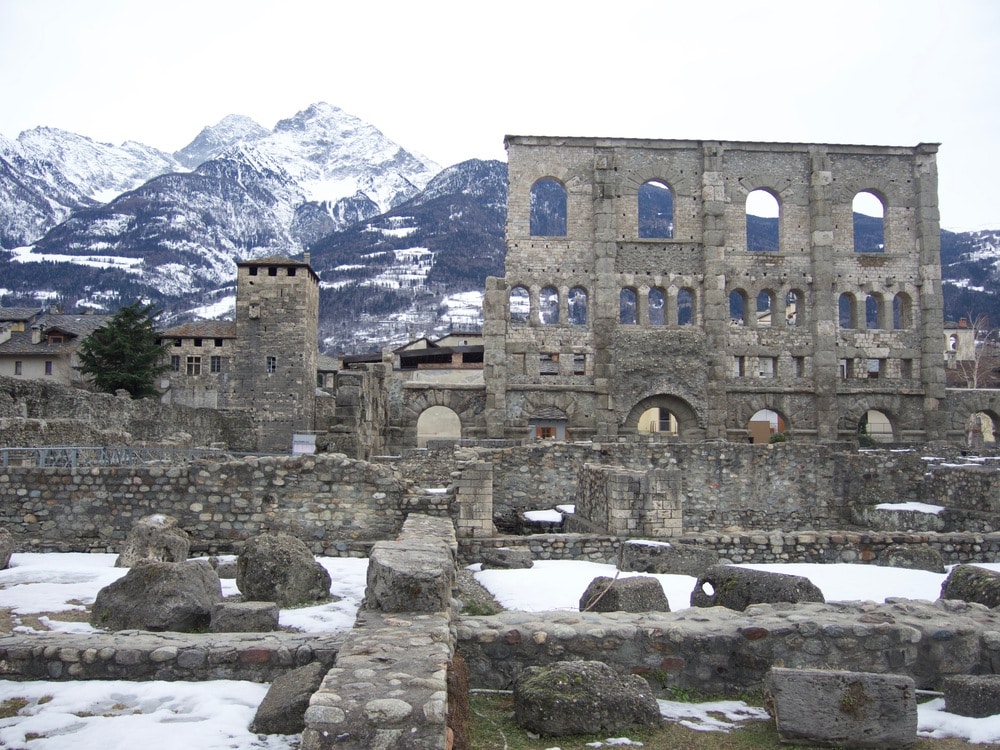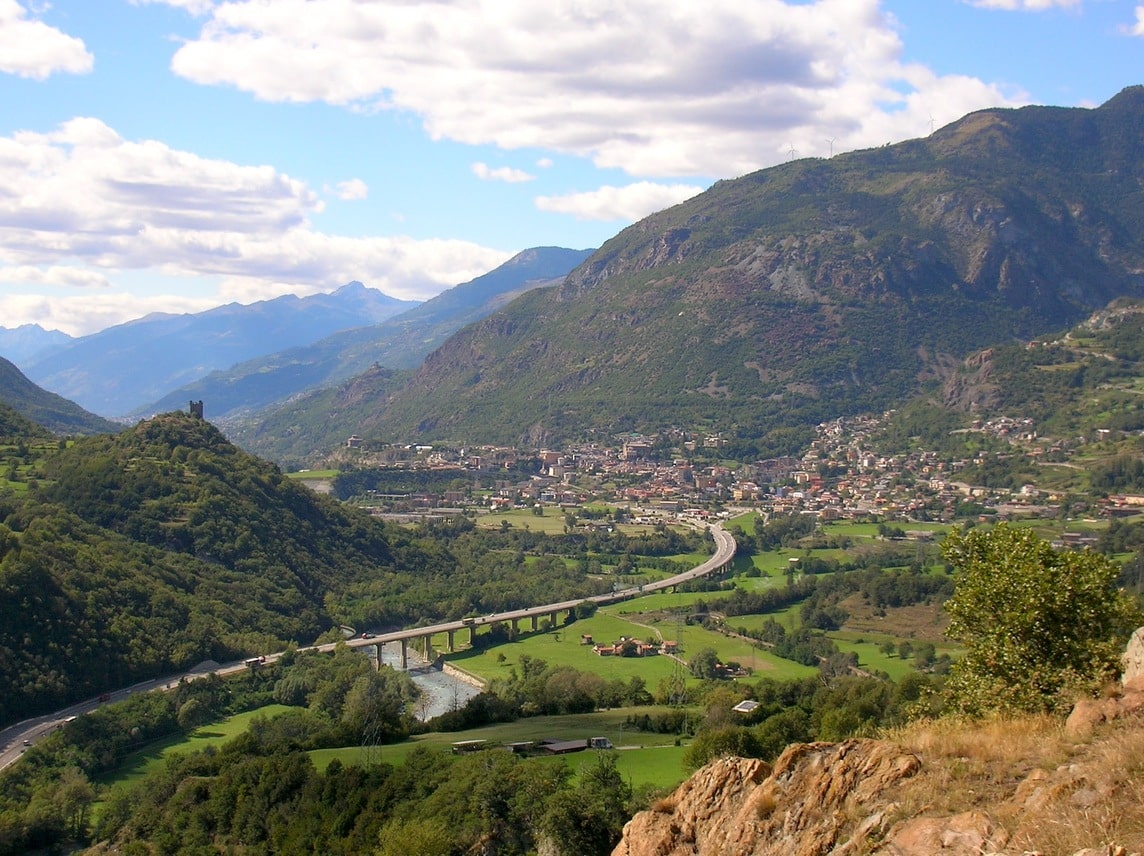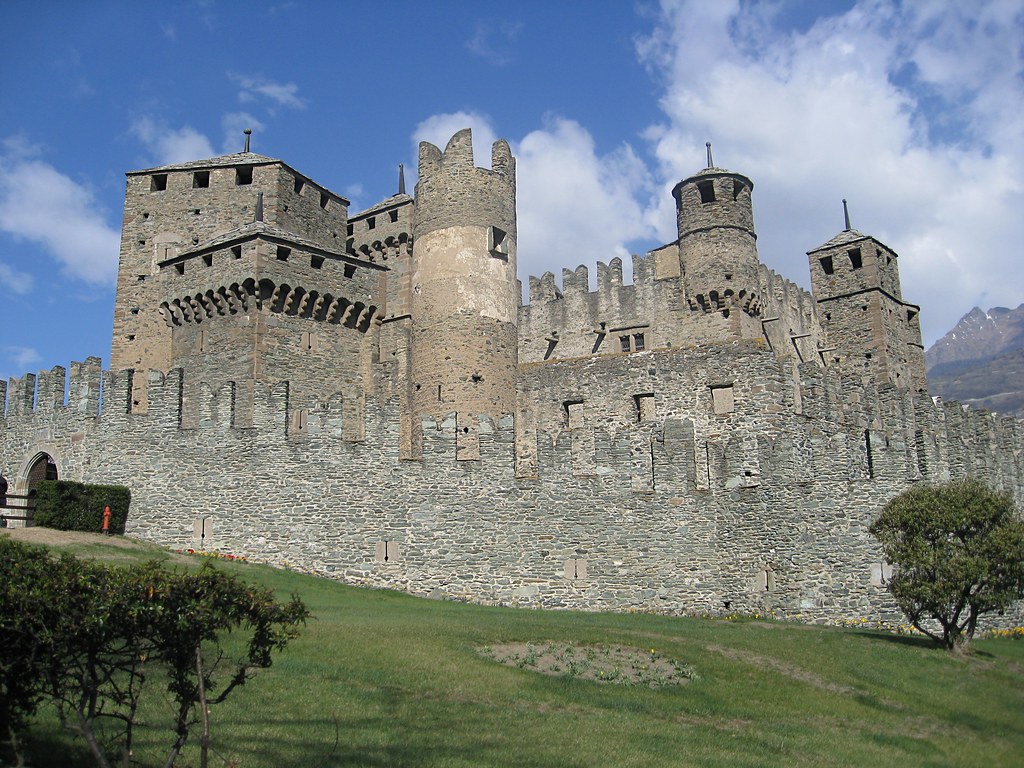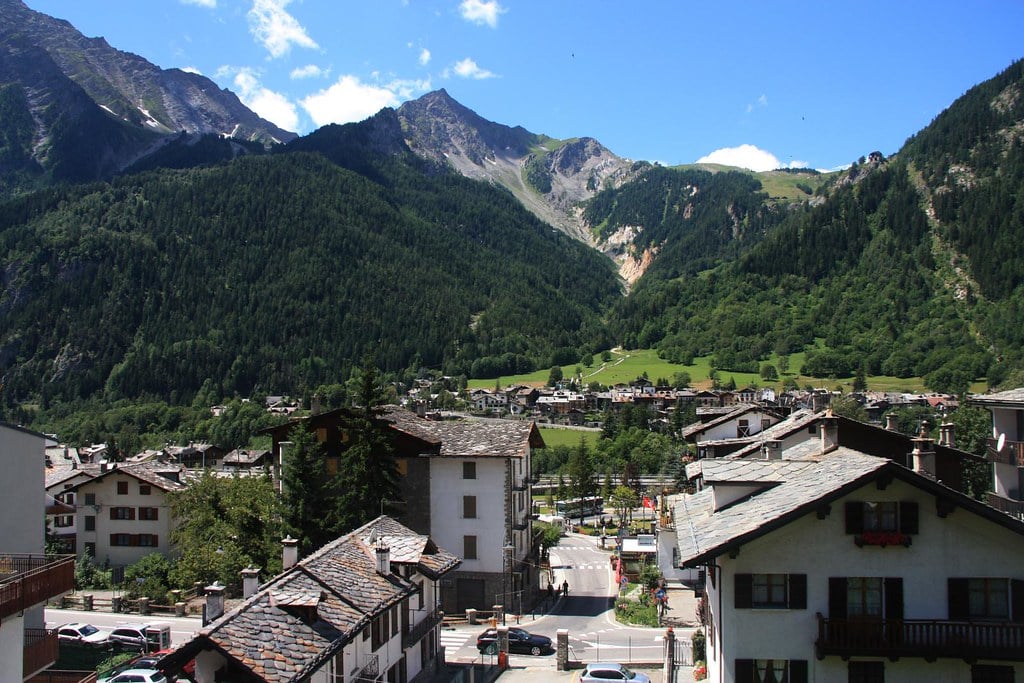From Pont-Saint-Martin to Courmayeur is the entire Aosta Valley. For those coming to the valley from Turin or Milan, they are the beginning and the end, before the Mont Blanc tunnel, of the region. Between the two villages is the entire central valley, there are villages and castles, parish churches and vineyards, forests and orchards, ancient bridges and bell towers, cheese factories and cellars, rocks and torrents.
An itinerary of discovery among the most spectacular in Italy, a long route in which the valleys converge, leading to the peaks, to the four-thousand-metre peaks, to the perennial glaciers where the many torrents that bathe the valley take shape. From Issogne to Verrès, from Chatillon to Chambave, from Fénis to Aosta, then on to Sarre and Morgex, until reaching Courmayeur, it is a continuous thrill, amid spectacular views and unique flavours.
Day 1: Pont-Saint-Martin and Aosta
It is the gateway to the Aosta Valley. When you arrive from the lands of Canavese, Pont-Saint-Martin is the first center of the region. Our Aosta Valley itinerary by electric car starts right here. We leave the car at the Plenitude+Be Charge column in via Nazionale per Donnas for recharging and take a walk in the village. A must see is the imposing stone bridge built by the Romans in the 1st century BC. in the heart of the town, an example of a large single span bridge.
At the mouth of the Lys valley which leads to Monte Rosa and its glaciers, Pont-Saint-Martin offers an area rich in paths including the famous Cammino Balteo which starts and ends right here, an itinerary that leads hikers to discover the history and culture of the central valley of the Alpine region.
Lunch with the classic Aosta Valley cutlets, prepared with veal stuffed with cooked ham and Fontina, the valley cheese par excellence, with a side dish of baked potatoes. To finish we taste the Aosta Valley tiles, a classic regional sweet prepared with hazelnuts, almonds and vanilla and with a typical thin disc shape.
Discovering Aosta
We leave Pont-Saint-Martin to continue towards Aosta. First the Donnas vineyards, the spectacular terraced landscapes where the Nebbiolo, Freisa and Neyret grapes are grown which give life to the Vallèe d’Aoste Donnas Doc, then the imposing silhouette of the Bard fort, nestled between the Donnas wine area and that of Arnad-Montjovet, home to an interesting museum complex, lead us to Issogne.
Among the most interesting manors in the Aosta Valley, we cannot miss it. Located in the heart of the village, on the outside it looks like an imposing block of austere shapes. The wonder is all within. In addition to proposing splendid fifteenth-century frescoes, depicting scenes of daily life, it offers the famous Pomegranate fountain and a beautiful baronial hall. Dinner with a platter of cured meats, including the delicious lard from Arnad, a town a stone’s throw from Issogne, and with a good lamb with herbs.

Day 2: Verrès and Châtillon
The morning takes us to the nearby village of Verrès, on the other bank of the Dora Baltea. Characterized by the presence of the castle, which dominates the town from the top of a cliff, it deserves a visit for its winding alleys, and for the history and architecture itinerary among the most interesting in the region.
The seventeenth-century chapel of Saints Barbara and James in Torille, with notable sacred furnishings, then that of San Grato, that of Our Lady of Sorrows, founded in 1678 by Martino Freydoz, and the architectural complex of the provostry of Saint-Gilles, from the eleventh century, which houses the sepulchral chapel of Ibleto di Challant and a stone three-mullioned window, a small masterpiece of Aosta Valley Gothic, are only part of the treasures of this village at the entrance to the Val d’Ayas, another valley that leads to the Monte Rosa massif.
The castle is the highlight of our visit to Verrès: one of the most evocative and well-preserved manors in the valley, it can be reached on foot. Of particular interest is the weapons room, with a pointed arch vault, equipped with two monumental fireplaces.
Châtillon Valley
Energetic and tasty lunch with a good plate of polenta concia, rich in Fontina cheese and melted butter. Before leaving Verrès we make a stop in one of the delicatessens in the area to buy cheese and yoghurt produced in the valleys. We then continue towards Châtillon, a large center in the central valley.
A path that winds through rocky gorges, the view of the ruins of the castle of Saint-Germain, that of the village of Saint-Vincent, home to the Casino de la Vallèe and the Thermal Baths, and, on the other side of the central valley, of the castle of Ussel, an extraordinary example of a monobloc manor.
An ancient commercial center, Châtillon was once the scene of important fairs and livestock markets, a destination for merchants from Valtournenche who came here to exchange their products. We visit the Gamba castle, perched on a rocky hillock overlooking Châtillon: built in stone at the beginning of the twentieth century, it has a symmetrical structure with a high central tower and is surrounded by a park of 7,000 square meters full of vegetation. The interior of the castle houses the collection of modern and contemporary art of the Valle D’Aosta Region.
It is the Aosta Valley carbonada that brightens up our dinner in the valley: prepared with beef and pork belly, we accompany it with a steaming polenta and wash it down with one of the best Aosta Valley wines, Torrette.

Day 3: Chambave and Fénis
A stone’s throw from Châtillon, on the road that leads to Aosta, is Chambave, one of the oenological capitals of the region. Land of vineyards and wines, Chambave deserves a stop in the cellar to taste a Chambave Muscat, a Nus Malvoisie and a Fumin. Chambave is a unique experience for those who love wine but also distillates, a journey through the history and flavors of the valley.
We then move again towards Aosta to stop in Fénis, where for lunch we treat ourselves to a platter of cheeses, with toma di Gressoney and Fontina, and cured meats, including mocetta, Saint-Marcel ham and Arnad lard.
The afternoon is entirely dedicated to the castle of Fénis, one of the most evocative fortified buildings in Italy. Dating back to the 13th century, it belonged to the Fénis branch of the powerful Challant family. Among the most visited monuments in northern Italy, it has crenellated walls, towers and internal rooms that allow visitors to immerse themselves in medieval castle life. A national monument since the end of the 19th century, it is certainly worth a visit if only for the beautiful courtyard decorated with splendid frescoes by the Jaquerian school.
Between gastronomy and culture in Aosta
We leave Fénis, an enchanting area of the valley immersed in the mountains a stone’s throw from the capital, to reach Aosta in the evening for a rich dinner. Let’s start with a taste of Jambon de Bosses, the typical ham from the Gran San Bernardo valley, followed by potato gnocchi with Gressoney toma cheese fondue, and finish with an apple tart. An evening stroll through the alleys of old Aosta and the beautiful Piazza Chanoux, the heart of the city, is not to be missed.
We leave the car at the Plenitude + Be Charge charging station in via Roma, after having covered most of the central valley, and enjoy the city. Lively center in the heart of the Alps, Aosta is beautiful all year round but particularly interesting during the Christmas period, with its Christmas markets scattered throughout the city. From architectural treasures to the Roman area, from churches to museums, from shops to delicatessens, the city offers continuous surprises.
Among its most scenic places is the Roman Theater, characterized by a series of buttresses and arches, with a facade measuring 22 meters in height and 65 meters in width. Another marvel of the city is the collegiate church of Sant’Orso, a monumental complex of particular charm and historical value where we are enchanted by the beauty of the cloister. Even the cathedral is worth a visit if only for its different styles, from Romanesque to Renaissance to Neoclassical. And then many purchases, from jams to wooden objects.
Lunch with some cured meats, a risotto with fondue and a taste of genepy, an excellent local digestive.

Day 4: Sarre and Morgex
We leave Aosta, after having recharged the car, and continue towards Mont Blanc.
A handful of kilometers from Aosta we stop in Sarre to visit its castle. Hunting residence of Vittorio Emanuele II and Umberto I of Savoy, then a summer holiday residence, the Royal Castle of Sarre houses original furnishings and a part used as a museum. The visit path between paintings, precious objects, sculptures and decorated rooms is beautiful: the hall and the gallery of trophies are enchanting, decorated with ibex and chamois horns.
We leave Sarre to continue towards Mont Blanc, stopping in the evening at Morgex, which welcomes us with its low pergola vineyards. Morgex is another of the wine capitals of the region where we treat ourselves to a tasty and substantial dinner of polenta and stew.

Day 5: Courmayeur and Val Veny
A walk through the village of Morgex, land of Blanc de Morgex and de La Salle, between the Pascal di la Ruine castle, the Bozel del Villair stronghold and the church of Santa Maria Assunta, before leaving for Courmayeur, the fashionable destination of the high valley. It is the view of the imposing silhouette of Mont Blanc that accompanies us along the road that leads us to Courmayeur, among rocky peaks, valleys and woods.
A combination of luxury and alpine tradition, high-level hotels and historic shops in Courmayeur you can breathe the Alps, their culture and the traditions of the high mountains. A walk through its shops and cafés in the center is well combined with a historic stop at the parish church of San Pantaleone. Among the shop windows and shops, the gaze often runs to the giant of the Alps, to Mont Blanc which looms over this portion of the Aosta Valley, with its rocks and glaciers.
Val Veny and its panoramas
For lunch we treat ourselves to one of the most traditional dishes of the region, the “Seupa à la Vapelenentse”, the traditional Valpellinense soup, prepared with meat broth, cabbage, fontina cheese, bread, butter and powdered cinnamon.
After a hearty lunch, for the afternoon we move to Val Veny, to the little church of Notre-Dame de la Guérison. The glance is breathtaking. The glaciers of Mont Blanc loom over us and the pungent air of the Alps blows on our faces. With a good glass of genepy and one of the most beautiful views in the Alps, we conclude our unforgettable itinerary by electric car in the Aosta Valley.










